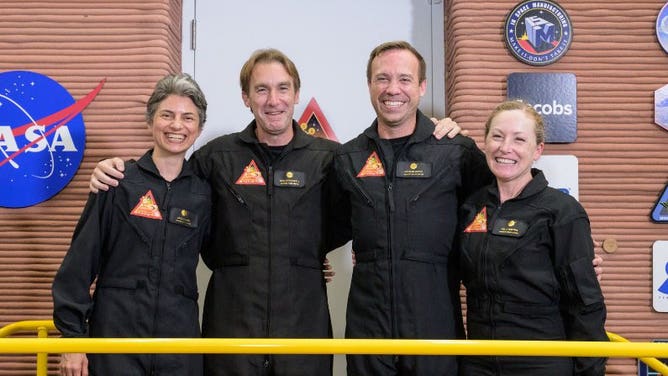4-Person crew leaves Mars simulator for first time in more than a year
During the Crew Health and Performance Exploration Analog project, the volunteers participated in simulated spacewalks, experiments and other activities intended to take place on the Martian surface.
NASA crew leaves Mars simulator for first time in more than a year
Four volunteers entered the habitat on June 25, 2023, and were allowed to leave on July 6. The 1,700-square-foot enclosure was in a facility at NASA’s Johnson Space Center and was designed to simulate a Mars mission.
HOUSTON – A crew of four people is now free to return to normal life after spending more than a year confined in a NASA simulator designed to replicate life on Mars.
Nathan Jones, Anca Selariu, Kelly Haston and Ross Brockwell entered the 1,700-square-foot enclosure back on June 25, 2023.
During the Crew Health and Performance Exploration Analog project, the volunteers participated in simulated spacewalks, experiments and other activities intended to take place on the Martian surface.
On Saturday, the crew walked out of their 3D-printed dome to applause at a facility at NASA’s Johnson Space Center in Houston.
MARS UNDER CONSTANT THREAT OF METEORITE STRIKES

Inside the Crew Health and Performance Exploration Analog project dome
(NASA)
"The simulation will allow us to collect cognitive and physical performance data to give us more insight into the potential impacts of long-duration missions to Mars on crew health and performance," Grace Douglas, a member of the CHAPEA team, said prior to the project.
"Ultimately, this information will help NASA make informed decisions to design and plan for a successful human mission to Mars."
Conditions were simulated to be as realistic as possible, including communication delays, limitations on resources and isolation.
The CHAPEA team did not report any major issues involving the volunteers during the 378 days.
NASA said data and observations collected during the project could potentially support future missions to the Moon and beyond.
NASA simulated 'Mars' habitat to help scientists understand future astronaut life
Fox News multimedia reporter Joy Addison on how four volunteers will begin a yearlong mission in NASA's newly revealed 'Mars' habitat.
NASA’S MARS ROVER RECORDS MILE-HIGH DUST DEVIL MOVING ACROSS RED PLANET
The space agency is readying for a long-term presence on the Moon during the Artemis program, which one day could lead to the exploration of the solar system’s fourth planet.
Several robotic missions are currently underway to enhance scientists' understanding of Mars, with the goal of humans reaching the surface by around 2040.
Mars is often called the "Red Planet" because of its reddish appearance, which is caused by its iron oxide.
The planet is, on average, some 140 million miles away from Earth, so a round-trip mission and stay would likely last several years.
The second simulated mission of the CHAPEA project is expected to begin during the first half of 2025.

Nathan Jones, Anca Selariu, Kelly Haston and Ross Brockwell of the Crew Health and Performance Exploration Analog project.
(NASA)

